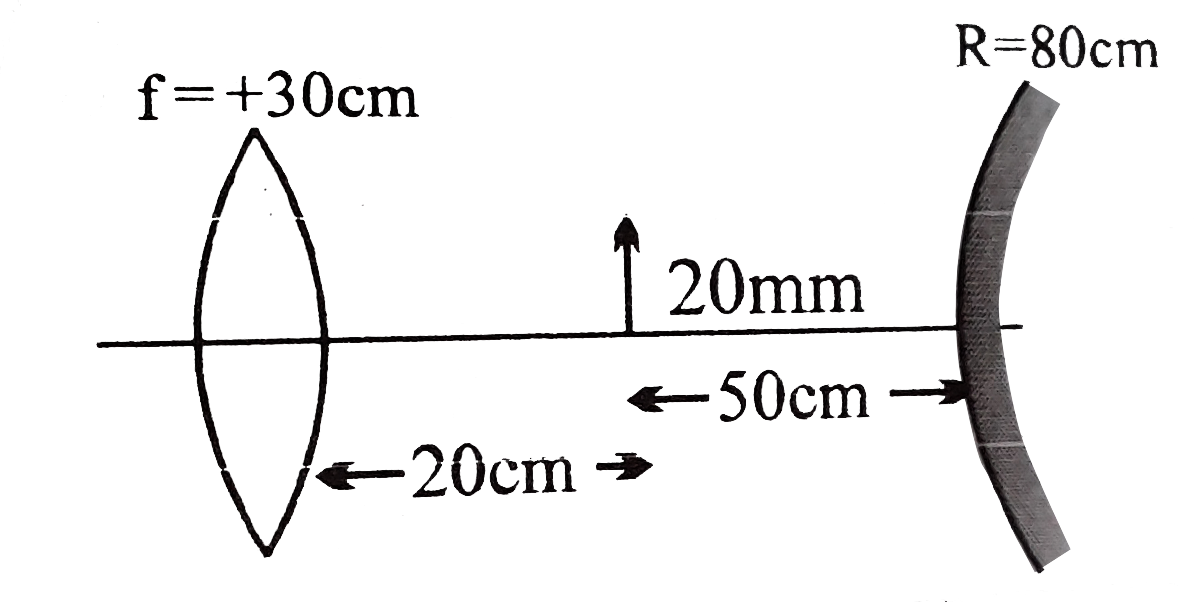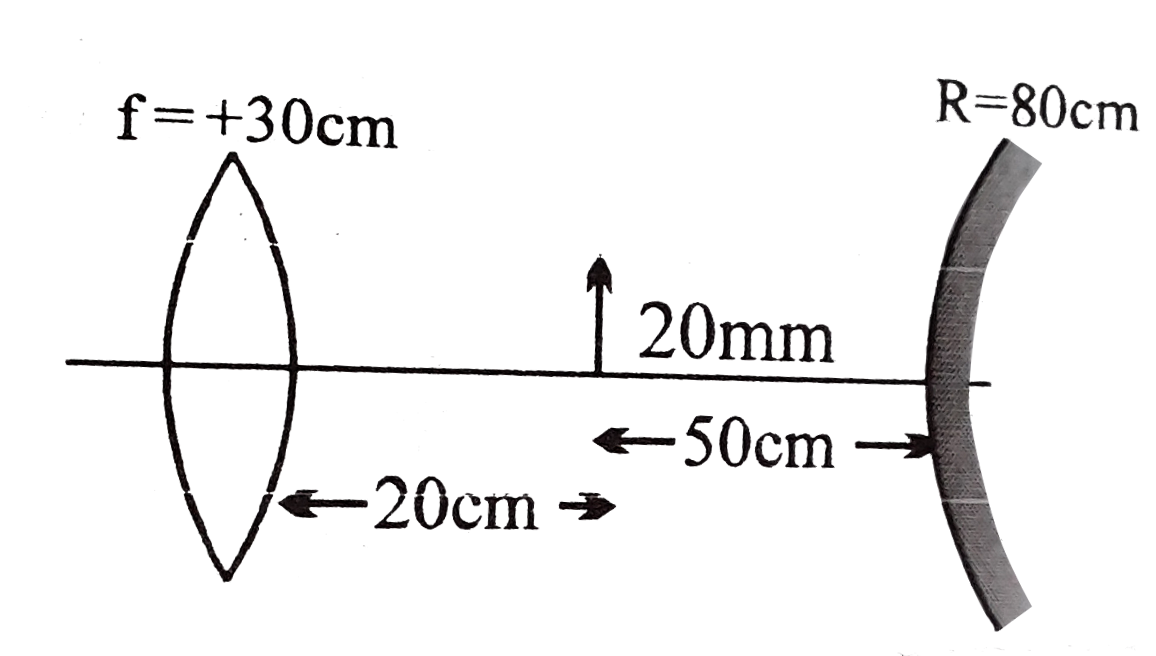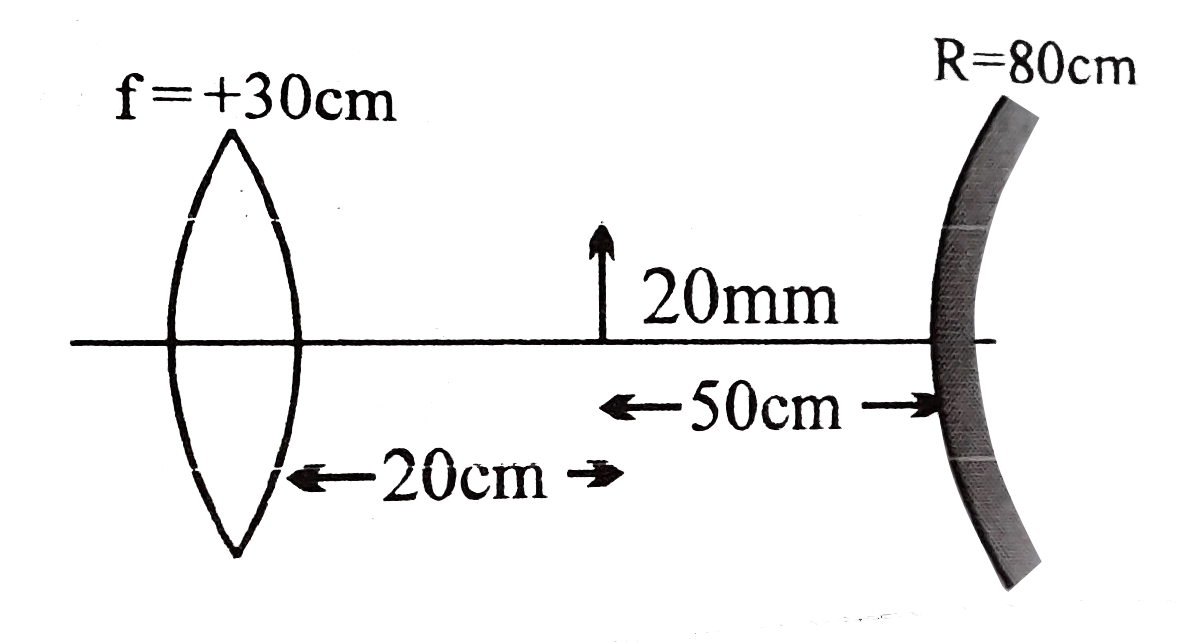An optical systen comprises in turn ,from left to right: an observer ,a lens of focal length+30cman object20mmhigh, and a convex mirror fo radius80cm .the object is between the lens and the mirror ,20cm from the lens and50cmfrom the mirror.The observe views the image formed first by reflection and then by refraction

in figure ,the position of the final image,measured from the mirror,in cm, is closest to
90
138
114
126
The correct Answer is:C
Step by step video, text & image solution for An optical systen comprises in turn ,from left to right: an observer ,a lens of focal length+30cman object20mmhigh, and a convex mirror fo radius80cm .the object is between the lens and the mirror ,20cm from the lens and50cmfrom the mirror.The observe views the image formed first by reflection and then by refraction in figure ,the position of the final image,measured from the mirror,in cm, is closest to by Physics experts to help you in doubts & scoring excellent marks in Class 11 exams.
Similar Questions
A concave lens of focal length 20 cm is placed 15 cm in front of a concave mirror of radius of curvature 26 cm and further 10 cm away from the lens is placed an object. The principal axis of the lens and the mirror are coincident and the object is on the axis Find the position and nature of the image.
View SolutionA converging lens of focal length 20 cm and a converging mirror of focal length 10 cm are placed 60 cm apart with common principal axis. A point source is placed in between the lens and the mirror at a distance of 50 cm from the lens. Find the locations of the images formed.
View Solution
Knowledge Check
- Question 1 - Select One
An optical systen comprises in turn ,from left to right: an observer ,a lens of focal length+30cman object20mmhigh, and a convex mirror fo radius80cm .the object is between the lens and the mirror ,20cm from the lens and50cmfrom the mirror.The observe views the image formed first by reflection and then by refraction

In figure ,the character of the final image ,with respect to the erect object is,Areal and erectBindeterminateCreal and invertedDvirtual and erect - Question 2 - Select One
An optical systen comprises in turn ,from left to right: an observer ,a lens of focal length+30cman object20mmhigh, and a convex mirror fo radius80cm .the object is between the lens and the mirror ,20cm from the lens and50cmfrom the mirror.The observe views the image formed first by reflection and then by refraction

In figure ,the character of the intermediate image formed by the mirror,with respect to the erect object ,isAvirtual and diminishedBreal and erectCindeterminateDvirtual and inverted - Question 3 - Select One
A biconvex lens of focal length 15cm is in front of a plane mirror. The distance between the lens and the mirror is 10cm. A small object is kept at distance of 30cm from the lens. The final image is
Avirtual and at a distance of 16 cm from the mirrorBreal and at a distance of 16cm from the mirrorCvirtual and at a distance of 20cm from the mirrorDreal and at a distance of 20cm from the mirror
The optical system consișt of a thin convex lens of focal length 30cmand a plane mirror 15cm behind the lens. An object is placed 15cm in front of the lens. The distance (in cm ) of final image from the lens is
View SolutionAn optical system consists of a thin convex lens of focal length 30cm and a plane mirror placed 15cm behind the lens. An object is placed 15cm in front of the lens. The distance of the final image from the object is
View SolutionA biconvex lens of focal length 15 cm is in front of a plane mirror. The distance between the lens and the mirror is 10 cm. A small object is kept at a distance of 30 cm from the lens. The final image is
View SolutionA biconvex lens of focal length 15 cm is in front of a plane mirror. The distance between the lens and the mirror is 10 cm. A small object is kept at a distance of 30 cm from the lens. The final image is
View SolutionAn object, a convex lens of focal length 20cm and a plane mirror are arranged as shown in the figure. How far behind the mirror is the second image formed?
 View Solution
View Solution

